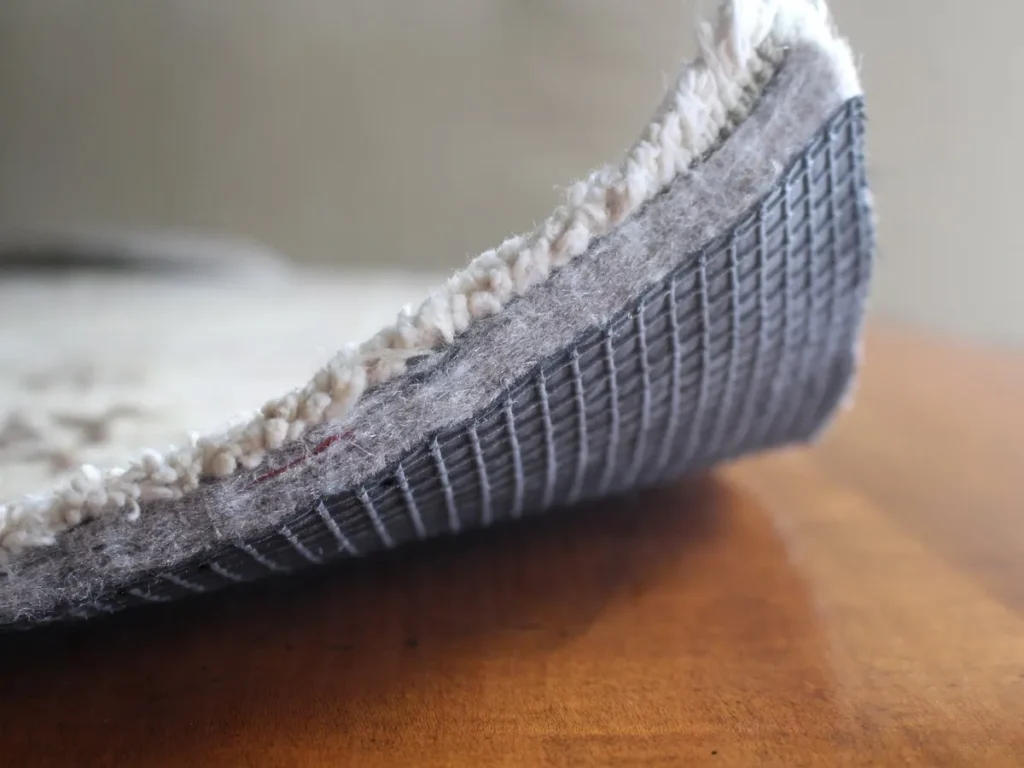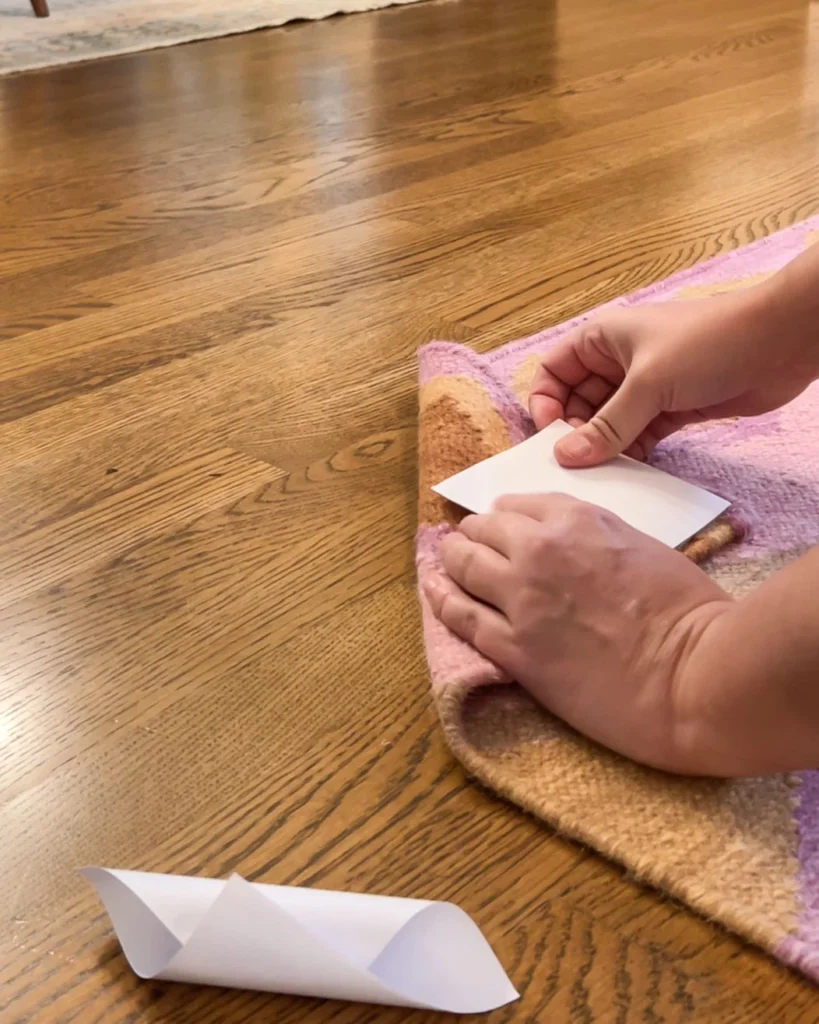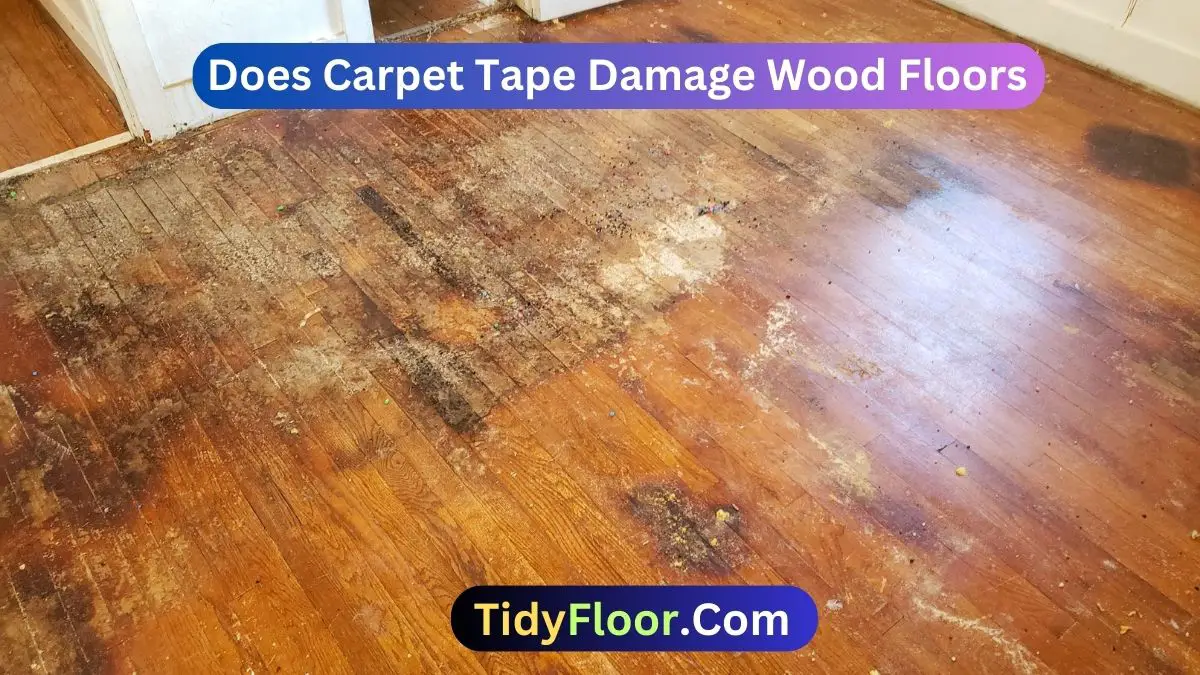Carpet tape serves as a convenient solution for securing carpets to various surfaces, including wood floors. However, concerns arise regarding its potential to cause damage. How much does carpet tape damage wood floors or it’s a safe bet?
Carpet tape can potentially damage wood floors. The adhesive residue left behind by the tape can bond with the wood finish, causing it to peel or discolor when the tape is removed. It’s advisable to use caution and test in an inconspicuous area before applying carpet tape.
This article explores the relationship between carpet tape and wood floors. Understanding these dynamics is crucial for homeowners seeking to maintain the integrity of their wood flooring.
Potential Risks Of Using on Does Carpet Tape damage Wood Floors:

The use of carpet tape on wood floors poses several risks that homeowners should be aware of.
#1- Residue Buildup:
Over time, the adhesive from the carpet tape can leave a sticky residue on the wood floor, which may be difficult to remove and can cause discoloration or damage to the finish.
#2- Surface Damage:
Improper application or removal of carpet tape can lead to damage to the wood floor surface, including scratches, scuffs, or peeling of the finish.
#3- Adhesion Problems:
If the carpet tape is not suitable for use on wood floors or is applied incorrectly, it may not adhere properly, leading to the carpet or rug shifting or slipping, creating a tripping hazard.
#4- Incompatibility with Finishes:
Certain types of carpet tape may not be compatible with all types of wood floor finishes, potentially causing damage or discoloration to the surface.
#5- Difficulty in Removal:
Some carpet tapes may be challenging to remove from wood floors, requiring excessive scraping or the use of harsh solvents, which can further damage the wood surface.
#6- Voided Warranty:
Using carpet tape on wood floors may void the warranty provided by flooring manufacturers, as it can be considered improper maintenance or installation.
#7- Potential Health Concerns:
Some carpet tapes contain chemicals or adhesives that may emit volatile organic compounds (VOCs) into the indoor air, posing health risks, especially in poorly ventilated spaces.
#8- Moisture Trapping:
Carpet tape applied improperly or left in place for an extended period can trap moisture between the tape and the wood floor, potentially leading to mold or mildew growth and damage to the wood.
#9- Staining:
Some carpet tapes may contain dyes or pigments that can transfer onto the wood floor, causing staining or discoloration, especially if the tape is exposed to moisture or sunlight.
#10- Uneven Surface:
If the carpet tape is not applied evenly or if the carpet or rug is not positioned correctly, it can create an uneven surface on the wood floor, posing a tripping hazard and detracting from the appearance of the flooring.
Types Of Carpet Tape Suitable For Wooden Floors:

Carpet tape, a versatile adhesive solution, plays a crucial role in securing carpets and rugs to various surfaces, including wood floors. Understanding the different types of carpet tape available is essential for homeowners and professionals alike. There are several types of carpet tape suitable for use on wooden floors, each offering specific features and benefits. Some common types include:
1- Double-Sided Cloth Tape:
This type of carpet tape features a cloth backing with adhesive on both sides. It provides strong adhesion and is suitable for securing carpets and rugs to wood floors securely.
2- Double-Sided Mesh Tape:
Mesh carpet tape is made of a mesh or grid pattern with adhesive on both sides. It offers excellent adhesion while allowing airflow, making it suitable for use on wood floors to prevent moisture buildup.
3- Double-Sided Film Tape:
Film carpet tape consists of a thin, clear film with adhesive on both sides. It provides a strong bond and is often used for temporary installations or on delicate wood floors to avoid residue or damage.
4- Heavy-Duty Carpet Tape:
Heavy-duty carpet tape is designed for high-traffic areas or heavy carpets. It offers extra-strong adhesion and durability, making it suitable for use on wooden floors where extra strength is required.
5- Removable Carpet Tape:
Removable carpet tape is designed to be easily removed without leaving residue or damaging the wood floor. It’s ideal for temporary installations or use on rental properties.
6- Moisture-Resistant Carpet Tape:
This type of carpet tape is specially formulated to resist moisture and humidity, making it suitable for use in bathrooms, kitchens, or other areas prone to water exposure.
7- Low-Profile Carpet Tape:
Low-profile carpet tape has a thinner profile, making it less visible under carpets and rugs. It provides secure adhesion while minimizing the risk of tripping or catching on the edges.
Benefits Of Using Carpet Tape Correctly On Wooden Floors:
Using carpet tape correctly on wooden floors, homeowners can enjoy these benefits while ensuring a safer, more functional, and visually appealing living space. Here are some crucial advantages of using carpet tape on wood floors.
1. Secure Placement:
Properly applied carpet tape ensures carpets and rugs remain firmly in place, reducing the risk of slipping or shifting and creating a safer environment for occupants.
2. Prevents Tripping Hazards:
By keeping carpets and rugs flat and stable, carpet tape helps prevent tripping hazards caused by loose or wrinkled floor coverings, particularly in high-traffic areas.
3. Protects Flooring:
Carpet tape helps protect wooden floors from damage caused by moving or sliding carpets and rugs, such as scratches, scuffs, or wear patterns, preserving the appearance and longevity of the flooring.
4. Enhances Aesthetics:
Neatly secured carpets and rugs contribute to a more polished and cohesive look in interior spaces, enhancing the overall aesthetics and visual appeal of the room.
5. Reduces Noise:
Securing carpets and rugs with carpet tape can help dampen noise transmission, particularly in multi-story homes or apartments, creating a quieter and more comfortable living environment.
6. Easy Installation:
Carpet tape is easy to apply and requires minimal tools or expertise, making it a convenient and cost-effective solution for homeowners looking to secure floor coverings without professional assistance.
7. Versatility:
Carpet tape can be used on various types of wooden floors, including hardwood, laminate, or engineered wood, making it a versatile option for different flooring materials and applications.
8. Temporary Solution:
Carpet tape offers a temporary solution for securing carpets and rugs in rental properties or during events or gatherings, providing stability without causing permanent damage to the wood floor.
How To Use Carpet Tape On Wood Floors Correctly To Avoid Damage:

To avoid damage when using carpet tape on wood floors, proper application is crucial. Follow these steps carefully to ensure secure placement of carpets and rugs without causing harm to the wood surface.
Step 1: Test In An Inconspicuous Area
Before applying carpet tape to the entire floor, test it in a small, inconspicuous area to ensure it doesn’t damage the wood finish or leave residue.
Step 2: Choose The Right Tape
Select a carpet tape specifically designed for use on wood floors. Look for tapes labeled as safe for hardwood surfaces and with strong adhesive properties that won’t leave residue.
Step 3: Clean The Surface
Thoroughly clean the wood floor to remove any dirt, dust, or debris. Use a mild cleaner and allow the floor to dry completely before applying the tape.
Step 4: Measure And Cut Carefully
Measure the area where the tape will be applied and cut it to the desired length using scissors or a utility knife. Avoid cutting too much tape or leaving excess, as this can lead to uneven adhesion.
Step 5: Apply The Tape Properly
Carefully place the cut pieces of carpet tape along the edges of the area where the carpet or rug will be placed. Ensure the tape is applied evenly and securely, with no gaps or overlaps.
Step 6: Avoid Direct Contact With Wood
When positioning the carpet or rug over the tape, avoid allowing the adhesive side of the tape to come into direct contact with the wood floor. This can prevent the tape from bonding too strongly to the wood surface.
Step 7: Use Removable Options
Consider using removable carpet tape or rug grippers that are designed to be easily removed without leaving residue or damaging the wood floor. These options provide a temporary solution for securing carpets and rugs.
Step 8: Monitor And Replace As Needed
Regularly check the carpet tape to ensure it’s not causing any damage to the wood floor. If you notice any signs of damage or residue buildup, remove and replace the tape promptly to prevent further issues.
Effects Of Excessive Use Of Carpet Tape:
Excessive use of carpet tape can lead to several adverse effects on both the carpet and the underlying surface. One significant consequence is the accumulation of adhesive residue, which can discolor and damage the surface, particularly in the case of wood floors.
Excessive tape application may cause the carpet fibers to become compressed or flattened, altering the texture and appearance of the carpet. Moreover, overuse of tape can make removal challenging, potentially resulting in surface damage or residue buildup. It’s crucial to use carpet tape sparingly and according to manufacturer recommendations to avoid these detrimental effects.
Alternative Methods For Securing Carpets:
Several alternative methods exist for securing carpets without relying solely on carpet tape. Here are some substitutes.
- Rug Pads:
Rug pads are non-slip mats placed underneath carpets and rugs to provide grip and prevent them from sliding on wooden floors. They come in various materials, such as rubber or felt, and thicknesses to suit different flooring types and preferences.
- Velcro Strips:
Velcro strips can be used to secure carpets and rugs to wooden floors. Adhesive-backed Velcro strips are applied to both the underside of the carpet/rug and the floor surface, creating a strong bond that prevents movement.
- Double-Sided Carpet Tape:
Double-sided carpet tape designed specifically for use on wood floors provides a strong, temporary bond between carpets and rugs and the floor surface. It offers a secure hold while allowing for easy removal when needed.
- Carpet Tacks or Staples:
Carpet tacks or staples can be used to secure the edges of carpets and rugs directly to the wooden floor. These fasteners are hammered or stapled into place along the perimeter of the carpet, holding it firmly in position.
- Area Rug Grippers:
Area rug grippers are adhesive-backed pads placed under the corners or edges of carpets and rugs to prevent them from curling or shifting on wooden floors. They provide a quick and easy solution for securing smaller rugs in place.
- Non-slip Rug Underlays:
Non-slip rug underlays are thin, mesh-like mats placed between carpets/rugs and the floor surface to enhance traction and prevent slipping. They are particularly useful for lightweight or thin rugs that may be prone to movement.
- Mechanical Fasteners:
For permanent installations, mechanical fasteners such as nails, screws, or brads can be used to secure carpets and rugs to wooden floors. These fasteners provide a long-lasting hold but may require professional installation.
- Weighted Objects:
In some cases, heavy furniture or objects placed on the edges or corners of carpets and rugs can help keep them in place on wooden floors, particularly in low-traffic areas or where temporary securing is sufficient.
Related question:
How Do You Tape Hardwood Floors?
To tape hardwood floors, use painter’s or delicate surface tape along the edges to protect the wood during painting or construction. Apply it where the wood meets walls or baseboards, and remove it carefully after the project. This prevents damage to the wood finish from paint or other materials.
Can Carpet Tape Be Removed?
Carpet tape can be removed. To remove it, gently peel off the tape from the surface. If any residue remains, use a mild adhesive remover or warm, soapy water to clean the area.
It’s important to follow the manufacturer’s instructions and test any cleaning solution in an inconspicuous area first.
How Long Does Carpet Tape Last?
The durability of carpet tape depends on factors like its quality, surface type, and level of foot traffic. Typically, high-quality tape can last anywhere from several months to over a year under standard conditions of use.
How Do You Remove Tape From The Hardwood Floor Without Damaging The Finish?
To remove the tape from a hardwood floor without damaging the finish, start by gently heating the tape with a hairdryer to soften the adhesive. Then, carefully peel off the tape using a plastic scraper or credit card. Finally, clean any residue with a mixture of warm water and mild detergent.
Conclusion:
Achieving a balance between convenience and floor protection is paramount when using carpet tape on wood floors. By understanding risks, using quality tape, and exploring alternative methods, homeowners can secure carpets effectively while safeguarding their wood flooring’s integrity and longevity.


